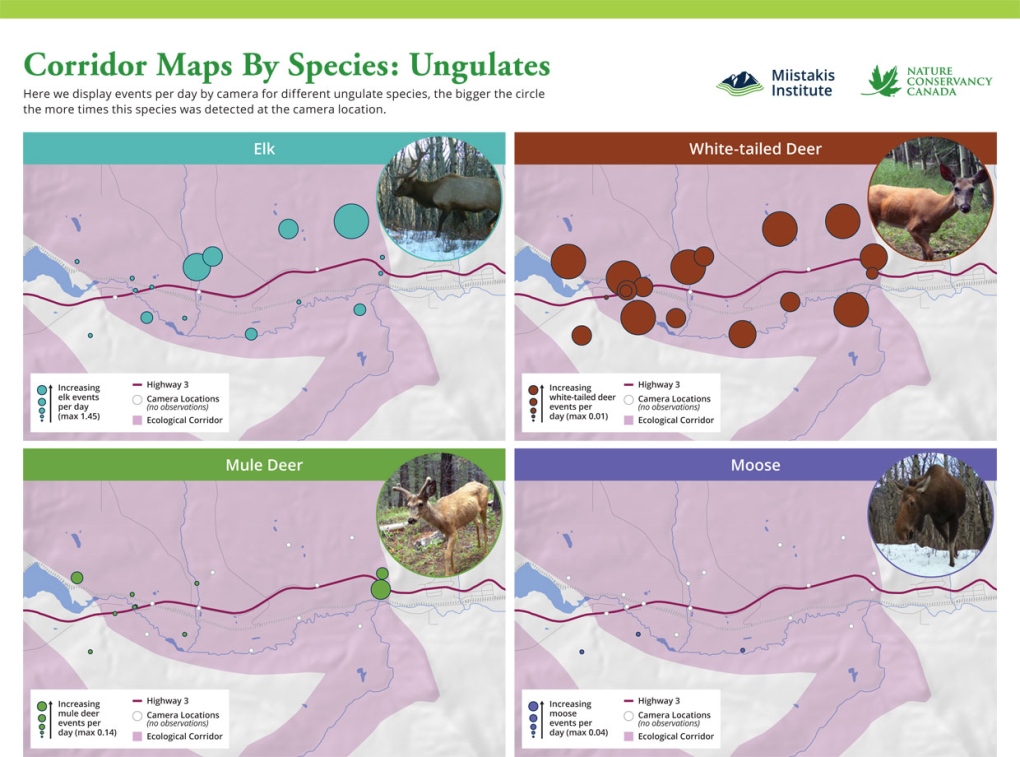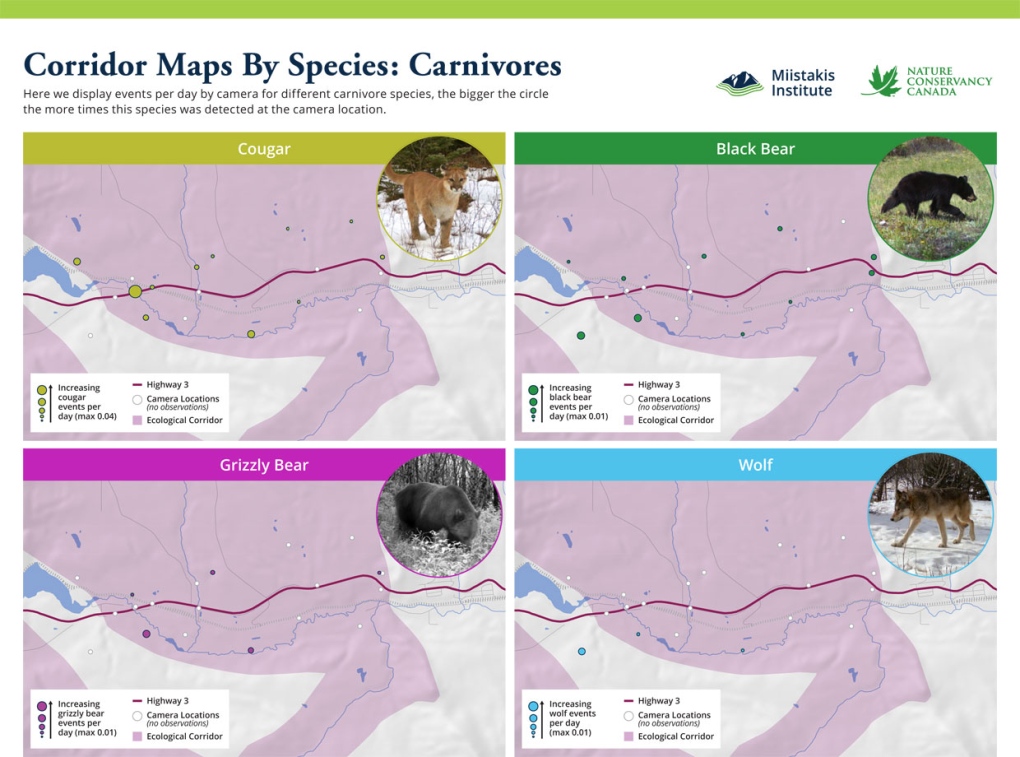Work needed to protect animals in Crowsnest Pass: study
Volunteers with a national conservation group have been watching and recording wildlife activity near a risky crossing in southern Alberta and say more needs to be done to protect animals.
The Nature Conservancy of Canada (NCC) has been working with the Miistakis Institute on a wildlife camera monitoring project in the Crowsnest Pass.
The strategy involved the installation of 37 remote cameras along Highway 3 in the Jim Prentice Wildlife Corridor.
The NCC says the region contains "the highest number of medium and large mammal species in North America."
"Twenty-one volunteers put in 333 volunteer hours managing the cameras and identifying species – including white-tailed deer, black bear, grizzly bear, wolf, cougar, moose, elk among others," the NCC said in a release.
One of the key findings, the NCC says, is that wildlife are actively crossing at the railway underpass and at the Crowsnest River Bridge.
That means there is "potential" to modify the crossing to improve safety for wildlife.
"The hope is these results will someday inform motor vehicle accident mitigation efforts in the area, to lower the risk of collisions for both people and wildlife," the NCC said.
Members of the Miistakis Institute also hope to use the situation to learn more about the animals in the region.
“One of the things we were trying to achieve is to understand is wildlife crossing Highway 3 using existing infrastructure, so culverts, the bridge underpass, railway underpass,” said director of conservation research Tracy Lee.
The group says wildlife often cross Highway 3, along with railway lines, to access food, water and for reproductive purposes.
The data collected so far is just the preliminary. The NCC says it will be using the cameras for the next three years.
"We will compare wildlife activity with wildlife-vehicle collision data and recommend road mitigation measures to help wildlife move safely across Highway 3," it said.
Now the group is using the data they've collected to reposition some cameras.
“After the first year, we can really see where we get more animals and where we might be problems,” said Emilie Brien, the natural area manager for the Crowsnest Watershed with the NCC.
“There are a few cameras I have some in areas where I know there are a lot of elk, but I didn't catch a lot of photos of elk, so that tells me that camera is probably not placed where it would be best.”
The report will highlight different solutions to help protect both wildlife and humans.
“Maybe it's fencing between structures they're currently using, or maybe it's a new underpass, for example, in an area they use to move across. We're hoping this research will inform that dialogue,” Lee said.
“The goal is to better understand how animals are moving in that wildlife corridor and to better inform our future decisions about how we manage development and wildlife,” Brien said.
The NCC says a total of 436,997 photos were taken throughout the first year, with 153,731 of those being of animals.


CTVNews.ca Top Stories

W5 investigation How did thieves steal your car? Maybe with a device they ordered online
Digital devices that a Toronto-area police department warns are used in the most common method of stealing cars are for sale online for anyone to buy, a W5 investigation has found.
Trump's appointees have criticized Trudeau, warned of border issues with Canada
Donald Trump's second administration is filling up with some of his most loyal supporters and many of the people landing top jobs have been critical of Prime Minister Justin Trudeau and security at Canada's border.
Elon Musk and Vivek Ramaswamy will lead new 'Department of Government Efficiency' in Trump administration
President-elect Donald Trump announced Tuesday that Elon Musk and Vivek Ramaswamy will lead a new 'Department of Government Efficiency' in his second administration.
Trump makes a victor's return to Washington to meet with Biden and GOP lawmakers
U.S. President Joe Biden will welcome Donald Trump to the White House on Wednesday for an Oval Office visit that is a traditional part of the peaceful handoff of power, a ritual Trump himself declined to participate in four years ago.
Here's why thieves may be stealing butter in Canada
The case of the missing butter remains a mystery, but some have ideas on what's behind the unusual crimes.
John Krasinski named People magazine's 2024 Sexiest Man Alive
John Krasinski is People magazine's Sexiest Man Alive for 2024.
South Korean actor Song Jae-lim found dead at 39
Song Jae-lim, a South Korean actor known for his roles in K-dramas 'Moon Embracing the Sun' and 'Queen Woo,' was found dead at his home in capital Seoul. He was 39.
Alleged serial killer previously pled guilty to 2018 attack on Waterloo, Ont. bus
The woman accused of killing three people in three days in three Ontario cities also previously admitted to attacking strangers on buses in the Region of Waterloo.
Chrystia Freeland says carbon rebate for small businesses will be tax-free
Deputy Prime Minister and Finance Minister Chrystia Freeland says the Canada carbon rebate for small businesses will be tax-free.


































